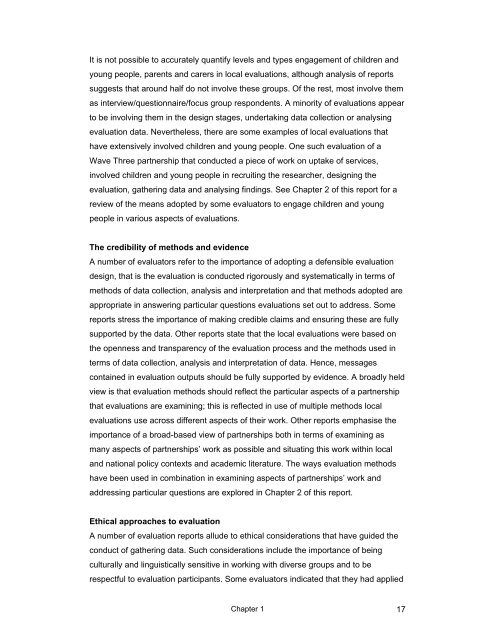Local Evaluation of Children's Services Learning from the Children's ...
Local Evaluation of Children's Services Learning from the Children's ...
Local Evaluation of Children's Services Learning from the Children's ...
- No tags were found...
You also want an ePaper? Increase the reach of your titles
YUMPU automatically turns print PDFs into web optimized ePapers that Google loves.
It is not possible to accurately quantify levels and types engagement <strong>of</strong> children andyoung people, parents and carers in local evaluations, although analysis <strong>of</strong> reportssuggests that around half do not involve <strong>the</strong>se groups. Of <strong>the</strong> rest, most involve <strong>the</strong>mas interview/questionnaire/focus group respondents. A minority <strong>of</strong> evaluations appearto be involving <strong>the</strong>m in <strong>the</strong> design stages, undertaking data collection or analysingevaluation data. Never<strong>the</strong>less, <strong>the</strong>re are some examples <strong>of</strong> local evaluations thathave extensively involved children and young people. One such evaluation <strong>of</strong> aWave Three partnership that conducted a piece <strong>of</strong> work on uptake <strong>of</strong> services,involved children and young people in recruiting <strong>the</strong> researcher, designing <strong>the</strong>evaluation, ga<strong>the</strong>ring data and analysing findings. See Chapter 2 <strong>of</strong> this report for areview <strong>of</strong> <strong>the</strong> means adopted by some evaluators to engage children and youngpeople in various aspects <strong>of</strong> evaluations.The credibility <strong>of</strong> methods and evidenceA number <strong>of</strong> evaluators refer to <strong>the</strong> importance <strong>of</strong> adopting a defensible evaluationdesign, that is <strong>the</strong> evaluation is conducted rigorously and systematically in terms <strong>of</strong>methods <strong>of</strong> data collection, analysis and interpretation and that methods adopted areappropriate in answering particular questions evaluations set out to address. Somereports stress <strong>the</strong> importance <strong>of</strong> making credible claims and ensuring <strong>the</strong>se are fullysupported by <strong>the</strong> data. O<strong>the</strong>r reports state that <strong>the</strong> local evaluations were based on<strong>the</strong> openness and transparency <strong>of</strong> <strong>the</strong> evaluation process and <strong>the</strong> methods used interms <strong>of</strong> data collection, analysis and interpretation <strong>of</strong> data. Hence, messagescontained in evaluation outputs should be fully supported by evidence. A broadly heldview is that evaluation methods should reflect <strong>the</strong> particular aspects <strong>of</strong> a partnershipthat evaluations are examining; this is reflected in use <strong>of</strong> multiple methods localevaluations use across different aspects <strong>of</strong> <strong>the</strong>ir work. O<strong>the</strong>r reports emphasise <strong>the</strong>importance <strong>of</strong> a broad-based view <strong>of</strong> partnerships both in terms <strong>of</strong> examining asmany aspects <strong>of</strong> partnerships’ work as possible and situating this work within localand national policy contexts and academic literature. The ways evaluation methodshave been used in combination in examining aspects <strong>of</strong> partnerships’ work andaddressing particular questions are explored in Chapter 2 <strong>of</strong> this report.Ethical approaches to evaluationA number <strong>of</strong> evaluation reports allude to ethical considerations that have guided <strong>the</strong>conduct <strong>of</strong> ga<strong>the</strong>ring data. Such considerations include <strong>the</strong> importance <strong>of</strong> beingculturally and linguistically sensitive in working with diverse groups and to berespectful to evaluation participants. Some evaluators indicated that <strong>the</strong>y had appliedChapter 1 17
















